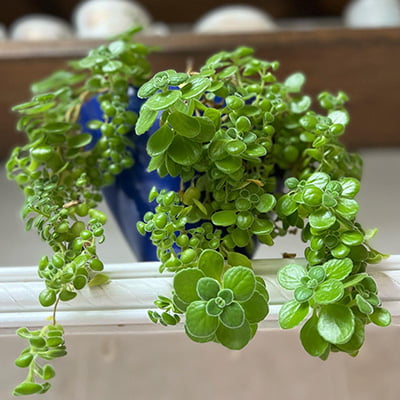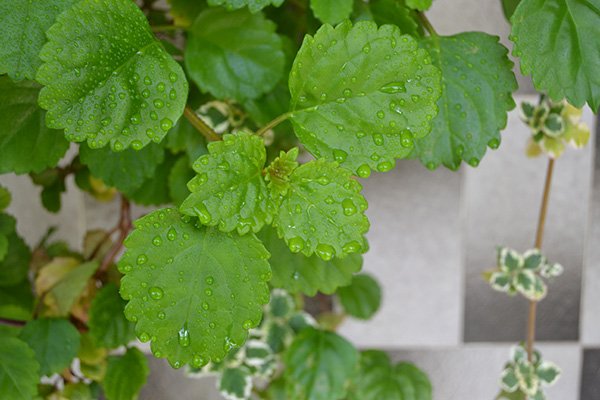Swedish ivy is a wonderfully sturdy little houseplant and the best choice for hanging baskets. It has trailing stems with prolific dark green leaves and really brightens up a corner or windowsill! As long as you don't overwater it, it's happy to grow simply!
Below, we'll discuss everything you'll need to know to grow this plant well and how to propagate it to share with others!
Botanical Name
Common Name
Plant Type
Mature Size
Sun Requirement
Soil Type
Hardiness Zone
Pet Friendly
Plectranthus verticillatus
Swedish ivy
Evergreen perennial
2-3 feet tall
Indirect light
Potting mix, well drained
10-11
Yes
What Is Swedish Ivy?
Swedish ivy (Plectranthus verticillatus) is somewhat misnamed, as it's native to southern Africa, not Sweden! It's also not a true ivy, as it does not grip surfaces. It's actually part of the mint family!
It has small, heart-shaped leaves with scalloped edges. These dark green leaves connect to purple-tinged, trailing vines, which explains why it has the nickname "Creeping Charlie"! Note that this is different than the ground ivy, also known as Creeping Charlie (Glechoma hederacea). That is typically considered to be a weed. Swedish ivy is also known as Swedish begonia - although it is neither Swedish nor in the same family as begonias!
Its trailing growth habit makes Swedish ivy a popular choice for hanging baskets or as garden ground cover. It typically tops out at three feet tall and wide. Swedish ivy typically won't bloom indoors, but you'll enjoy small purple or white flowers if you grow your Swedish ivy outside.
Some hybrid varieties of Swedish ivy will have purple leaves to match the color of the stem. Others have leaves with white margins or fully variegated leaves with white markings throughout each leaf.

Swedish Ivy Care Requirements
Light
Swedish ivies need lots of light, but the bright, direct sun frequently kills them. Choose a growing location that gets plenty of indirect sunlight. An east-facing window allows for ample light, with the morning sun milder, and the afternoon sun of a west-facing window will likely be too much light.
Water
It's important not to overwater Swedish ivy! During the spring and summer, you'll need to water your Swedish ivy plant once a week, but always check the soil moisture with your finger first—only water when the top two inches of the soil feel dry.
In the fall and winter, your plant won't use as much water and will take longer to dry out between waterings. Wait two or three weeks between each watering, and feel down four inches into the soil to test for dryness.
Temperature
Don't let the "Swedish" in the plant name fool you - this plant lies in hot temperatures. It can be grown outdoors year-round in USDA Hardiness Zones 10 and 11. For most of the United States, Swedish ivy grows best as an indoor houseplant. Many gardeners will move it outside during the summer, often in a hanging basket. Just be sure to move it back indoors when the temperatures drop below 60 degrees Fahrenheit. Average room temperatures of 65 to 75 degrees Fahrenheit are perfect.
Humidity
Swedish ivy prefers warm climates with high humidity, although it can handle most households' low to moderate humidity. However, if you want your Swedish ivy plant to really thrive, it would be a good idea to both the humidity level near the plant. Here are some ways to do this:
Use a humidifier
During the winter months, your whole house could probably benefit from a humidifier! But even a small one placed near your plant will do the trick.
Use a pebble tray
Fill a dish with pebbles, then fill it with water just so that the tops of the pebbles are still above the water. Place the pot atop these pebbles. As the water in the tray evaporates, it increases the air moisture directly around the plant.
Place plants together
All plants boost the humidity in the air around them. By grouping humidity-loving plants together, they'll all help each other out.
Soil
Swedish ivy plants prefer a soil pH between 5.5 and 6.5; handily enough, this is the pH of most standard potting mixes! It's important that the soil is well draining. Some gardeners mix peat moss into a potting mix to prevent battling soggy soil later.
Fertilization
Swedish ivy grows quickly in the spring and summer, and balanced or low nitrogen fertilizer will help support its growth. Apply this fertilizer every two to three weeks. Don't fertilize at all in the fall and winter, when it's not the growing season, and you'll likely burn the roots.
Pruning
You'll find that Swedish ivies do best with regular pruning. Use clean shears to clip away any unruly stems every couple of weeks. This will help keep your plant from getting too leggy and encourage branching from each stem to make a bushier, fuller plant.
After Swedish plant flowers fade, pinch back the stem tips to encourage new growth and branching.
Propagation
Swedish ivy is a particularly easy plant to propagate. A Swedish ivy plant in the Oval Office dates back to 1961, and cuttings are often gifted to White House aides! Here's how to propagate your own plant from stem cuttings.
Using clean shears, clip a stem cutting. You can take stem tip cuttings at any time of the year, although spring and summer are best. Choose a vine with thick stems and younger, smaller leaves. Clip a cutting five to six inches long, cutting at a 45-degree angle above a leaf node.
Remove the leaves from the bottom half of the cutting, and dip this end in a rooting hormone. While not necessary, this powder does significantly speed up the propagation process.
Plant the cutting in a small pot (with drainage holes!) filled with moist potting soil. Keep the soil consistently moist until roots form. You can also place your cutting directly in a cup of clean water. If you go this route, change out the water every two days. Place the pot or cup on a windowsill with plenty of indirect light.
You should see new plants' roots in two to three weeks! Once your cutting has taken root, plant it in its permanent container.

Source: Flickr
Common Problems With Swedish Ivy Plants
You can avoid most of the problems with your Swedish ivy by careful watering.
Spider Mites
Spider mites will show up if your plant is overly dry. However, because the roots of Swedish ivy are so sensitive to overwatering, it's best to prevent spider mites through humidity levels. Boost humidity, and spider mites should stay away! If you do see some, simply treat your plant with insecticidal soap.
Root Rot + Yellow Leaves
It's important not to overwater Swedish ivy! It's very prone to root rot. You'll know you've got root rot on your hands when the leaves begin to wilt and turn yellow. Unpot the plant, let the roots dry out, discard any sick roots, and replant the Swedish ivy in fresh soil.
Is Swedish Ivy Pet Friendly?
Swedish ivy is completely nontoxic and is safe for pets and children if they accidentally ingest it.
